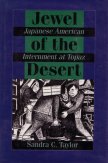
Jewel of the Desert: Japanese American Internment at Topaz

Sandra C. Taylor, 1993
The introduction establishes the parameters of the book, stating what group of Japanese Americans it deals with , uses the term "concentration camp" to describe Topaz and establishes the authors own feelings about the internment program.
The first chapter deals with the history of the Japanese settlement into the San Francisco area of California. It goes into the types of businesses that the Issei and Nisei established, educational problems their children ran into, and the overall structure of the Japanese American community in that area.
The chapter also covers the anti-immigration movement, the effect of the Great Depression on the community and how the community grew.
The next chapter goes into what happened after the attack on Pearl Harbor, including the arrests, Executive Order 9066, etc.
The next chapter starts with moving people to the Tanforan Assembly Center. The author points out that Tanforan was not ready at all to accept the internees as shown by the types of meals the people had to eat for the first ten days which were basically lima beans, cold tea, canned food, stale bread, boiled potatoes and canned Vienna sausage. The horse stalls without roofs are described and she also points out the strong desire on the part of the Nisei to prove themselves good citizens which, in itself, helped stop a lot of trouble along with the fact that the JACL was being "accomodationist."
Religious services were actually controlled as to the content. Various recreational activities got underway and the leadership changed from the Issei generation to the Nisei generation. Next to be gone into is the "self-government" setup at the center. Then the residents are moved to the Topaz internment camp.
The next chapter starts off with how the Topaz camp was constructed. The nature of the camp administration is discussed, and then the movement of college students into other states to continue their education. The overall difficulties involved with resettlement are also discussed.
The next chapter starts off talking about the schools that were set up at Topaz. Discussed is the fact that the schools were not ready physically (they had to shut down for a month until the schools were winterized), and the uneven teacher quality. Also covered is the appearance of juvenile delinquency which had not previously been any sort of a problem for Japanese-American youths.
The book then goes into the killing of one of the inmates by a guard. The author discusses the event in detail and particularly what followed immediately afterwards, with, in effect, an attempt by the military to cover up what had happened and an almost complete disinterest on the part of non-camp newspapers. It was also apparently not the only time that sentries had fired at internees who were near the fence.
A lot of time is spent on the incident (a man was shot and killed when he was near the fence; he might have been trying to escape, he might have been playing with a dog, he might have been reaching for a flower, he might have been partially deaf and never heard any warnings, etc.). The exact circumstances of the shooting have never been definitively determined.
The loyalty questionnaire is discussed along with the arrangement of camp politics, and then the segregation of the "no-no's" to Tule. Problems of Kibei violence in beating up "pro-administration" internees is then covered along with labor troubles at a strike at the camp.
The relationship of those in the camp with the nearby town of Delta are discussed, and it's pointed out that, basically, the relationship was a good one for both sides. The draft of the Nisei is then covered. The author discusses what happened as more and more people left the camp in the last year and a half of its existence, and how there were fewer people behind, their attitudes were not very positive and some people were actually fearful to leave the camp and relocate to some other area of the country.
There's a lot of detail on different aspects of the camp life and the problems each was having from the hospitals through the education program, which was essentially falling apart. The process of actually closing the camp and the kinds of problems that caused is next to be discussed.
The next chapter covers the effect of internment on the lives of the people in general and with many specific examples. The problems of moving back to the West Coast are covered, including the anti-Japanese feelings still prevalent there. An extensive notes section and bibliography follows.
This is a good book with specific examples of how the camp life influenced the lives of the people there and an in-depth examination of the shooting death of one internee, covered in more detail than I've seen elsewhere. A good and interesting book.
Main Index
Japan main page
Japanese-American Internment Camps index page
Japan and World War II index page
|